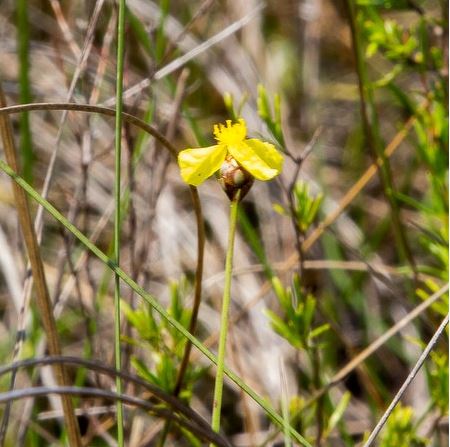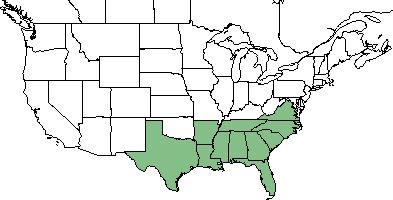Difference between revisions of "Xyris ambigua"
(→Ecology) |
|||
| Line 32: | Line 32: | ||
==Ecology== | ==Ecology== | ||
===Habitat=== <!--Natural communities, human disturbed habitats, topography, hydrology, soils, light, fire regime requirements for removal of competition, etc.--> | ===Habitat=== <!--Natural communities, human disturbed habitats, topography, hydrology, soils, light, fire regime requirements for removal of competition, etc.--> | ||
| − | ''X. ambigua'' can be found in communities that are not human disturbed, ranging from wet savannahs and flatwoods to pinelands and edges of depression ponds. <ref name= "Weakley"> Weakley, A. S. (2015). Flora of the Southern and Mid-Atlantic States. Chapel Hill, NC, University of North Carolina Herbarium. </ref> | + | ''X. ambigua'' can be found in communities that are not human disturbed, ranging from wet savannahs and flatwoods to pinelands and edges of depression ponds. <ref name= "Weakley"> Weakley, A. S. (2015). Flora of the Southern and Mid-Atlantic States. Chapel Hill, NC, University of North Carolina Herbarium. </ref> Other communities include moist sands or sandy-peats of bog margins, and lakeshores. <ref name= "Kral"/> As well, ''X. ambigua'' has been observed in a range of habitats including moist loamy sand in distubed sites and savannahs, moist sandy peat in cypress domes, wet sandy peat in pine flatwoods, wet acid sands, and other bogs. <ref name= "Herbarium"> Florida State University Robert K. Godfrey Herbarium database. URL: http://herbarium.bio.fsu.edu. Last accessed: June 2018. Collectors: Loran C. Anderson, Steve L. Orzell, Edwin L. Bridges, R. Kral, R. K. Godfrey, O. Lakela, P. L. Redfeam, Robert L. Lazor, Sidney McDaniel, Wilson Baker, Ann F. Johnson, Wendy Casper, Bob Rjce, K. Craddock Burks, A. H. Curtiss, John Morrill, N. C. Henderson, Bruce Hansen, M. Davis, R. A. Norris, A. F. Clewell, Cecil R. Slaughter, T. MacClendon, K. MacClendon, and A. Gholson. States and counties: Florida: Wakulla, Nassau, Franklin, Gulf, Liberty, Martin, Leon, Citrus, Collier, Charlotte, Brevard, Jackson, Hillsborough, Orange, Bay, Walton, Okaloosa, Levy, Escambia, Santa Rosa, Holmes, Washington, Calhoun, Pasco, Jefferson, Palm Beach, Indian River, Lee, Hernando, Pinellas, Taylor, Duval, and St. Johns. Georgia: Thomas, Grady, and Coffee. Alabama: Escambia and Calhoun. </ref> |
| + | |||
| + | Associated species - ''Scleria reticularis'', ''Buchnera floridana'', ''Hypericum opacum'', ''Eryngium integrifolium'', ''Xyris elliottii'', ''Habenaria integra'', ''Polygala ramosa'', ''Polygala lutea'', ''Ctenium aromaticum'', ''Hibiscus aculeatus'', ''Xyris brevifolia'', ''Xyris caroliniana'' <ref name= "Herbarium"/> | ||
===Phenology=== <!--Timing off flowering, fruiting, seed dispersal, and environmental triggers. Cite PanFlora website if appropriate: http://www.gilnelson.com/PanFlora/ --> | ===Phenology=== <!--Timing off flowering, fruiting, seed dispersal, and environmental triggers. Cite PanFlora website if appropriate: http://www.gilnelson.com/PanFlora/ --> | ||
Revision as of 19:49, 15 June 2018
Common names: coastal plain yelloweyed grass
| Xyris ambigua | |
|---|---|

| |
| Photo by John Bradford hosted at Bluemelon.com/poaceae | |
| Scientific classification | |
| Kingdom: | Plantae |
| Division: | Magnoliophyta - Flowering plants |
| Class: | Liliopsida - Moncots |
| Order: | Commelinales |
| Family: | Xyridaceae |
| Genus: | Xyris |
| Species: | X. ambigua |
| Binomial name | |
| Xyris ambigua Kunth | |

| |
| Natural range of Xyris ambigua from USDA NRCS Plants Database. | |
Contents
Taxonomic Notes
Synonyms: none
Varieties: none
Description
Also known as coastal plain yelloweyed grass, X. ambigua is a native perennial forb that is a member of the Xyridaceae family. [1] The leaves are broadly linear, 15-40 cm long, curvate of slightly twisted, and tips either blunt or acute. Bracts ranging reddish-brown to pale brown, while lateral sepals tan to reddish with a broad, ciliate keel. [2]
Distribution
It is native to the southeast United States, ranging from eastern Texas to Virginia, mostly occupying areas along the coastline. [1]
Ecology
Habitat
X. ambigua can be found in communities that are not human disturbed, ranging from wet savannahs and flatwoods to pinelands and edges of depression ponds. [3] Other communities include moist sands or sandy-peats of bog margins, and lakeshores. [2] As well, X. ambigua has been observed in a range of habitats including moist loamy sand in distubed sites and savannahs, moist sandy peat in cypress domes, wet sandy peat in pine flatwoods, wet acid sands, and other bogs. [4]
Associated species - Scleria reticularis, Buchnera floridana, Hypericum opacum, Eryngium integrifolium, Xyris elliottii, Habenaria integra, Polygala ramosa, Polygala lutea, Ctenium aromaticum, Hibiscus aculeatus, Xyris brevifolia, Xyris caroliniana [4]
Phenology
Common flowering time ranges from June to September as well as the month of November. [5]
Fire ecology
X. ambigua has shown significant increase in flowering response due to the introduction of fire. [6]
Conservation and Management
This species is listed as endangered in the state of Tennessee. [1]
Cultivation and restoration
Photo Gallery
References and notes
- ↑ 1.0 1.1 1.2 USDA Plants Database URL: https://plants.usda.gov/core/profile?symbol=XYAM
- ↑ 2.0 2.1 Kral, R. (1960). "The genus Xyris in Florida." Rhodora 62(743): 295-319.
- ↑ Weakley, A. S. (2015). Flora of the Southern and Mid-Atlantic States. Chapel Hill, NC, University of North Carolina Herbarium.
- ↑ 4.0 4.1 Florida State University Robert K. Godfrey Herbarium database. URL: http://herbarium.bio.fsu.edu. Last accessed: June 2018. Collectors: Loran C. Anderson, Steve L. Orzell, Edwin L. Bridges, R. Kral, R. K. Godfrey, O. Lakela, P. L. Redfeam, Robert L. Lazor, Sidney McDaniel, Wilson Baker, Ann F. Johnson, Wendy Casper, Bob Rjce, K. Craddock Burks, A. H. Curtiss, John Morrill, N. C. Henderson, Bruce Hansen, M. Davis, R. A. Norris, A. F. Clewell, Cecil R. Slaughter, T. MacClendon, K. MacClendon, and A. Gholson. States and counties: Florida: Wakulla, Nassau, Franklin, Gulf, Liberty, Martin, Leon, Citrus, Collier, Charlotte, Brevard, Jackson, Hillsborough, Orange, Bay, Walton, Okaloosa, Levy, Escambia, Santa Rosa, Holmes, Washington, Calhoun, Pasco, Jefferson, Palm Beach, Indian River, Lee, Hernando, Pinellas, Taylor, Duval, and St. Johns. Georgia: Thomas, Grady, and Coffee. Alabama: Escambia and Calhoun.
- ↑ PanFlora URL: http://www.gilnelson.com/PanFlora/
- ↑ Hinman, S. E. and J. S. Brewer (2007). "Responses of Two Frequently-Burned Wet Pine Savannas to an Extended Period without Fire." The Journal of the Torrey Botanical Society 134(4): 512-526.